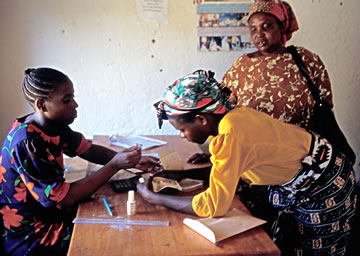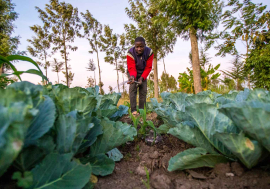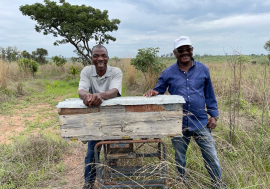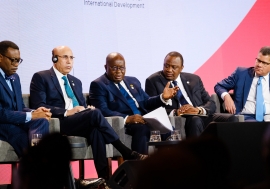Mobilizing money at the grass roots
 Members of a Kenyan women’s dairy cooperative receiving payments: Investment and savings clubs help such small enterprises expand their operations.
Members of a Kenyan women’s dairy cooperative receiving payments: Investment and savings clubs help such small enterprises expand their operations.Across the continent, Africans are saving and investing more of their own money. Such improvements are especially important, as Africa’s prospects for external funding look ever more uncertain at a time of global financial turmoil.
According to the UN Economic Commission for Africa (ECA), headquartered in Addis Ababa, Ethiopia, the region’s domestic savings rate rose from just 19 per cent of gross domestic product (GDP) in 1998–2001 to 26 per cent in 2007. Similarly, Africa’s domestic investment rate increased from 19.7 per cent to 22.1 per cent over the same period, according to the ECA’s Survey of Economic and Social Conditions in Africa, released in March 2008.
Kenya has been among the African countries showing such improvements, although political instability and economic mismanagement have kept its savings and investment rates below the African average. Despite the shortcomings, one of the strengths of Kenya’s performance has been the growth in recent years of savings groups, which have helped many ordinary Kenyans channel their savings into productive investments.
Currently, local investment clubs hold a total of about 35 bn Kenyan shillings, equivalent to US$469 mn, reports Patrick Kariuki, chairman of the Kenya Association of Investment Groups (KAIG). That is just a small portion of the KSh642 bn in total bank deposits in Kenya in 2007, but still more than twice all the foreign grants the country received that year.
 A worker for a Kenyan savings group goes through the Kibera slums of Nairobi to collect savings deposits from small-scale traders.
A worker for a Kenyan savings group goes through the Kibera slums of Nairobi to collect savings deposits from small-scale traders.Kenyans call such groups chamas, loosely translated as “committees.” They began as a means of survival during the economically troubled 1980s and 1990s. Relatives, neighbours or work colleagues would pool some of their resources under a chama and use the money as a fund for borrowing and lending among members in times of difficulty. As the country’s economic health improved, members would use the same funds to start small businesses.
Over time, clubs started formalizing their relationships, with some registering as companies and investing in stocks and real estate. Today, according to Mr. Kariuki, one in every three adult Kenyans is a member of an investment club. “We believe that these clubs have a lot of potential. If the capital they have is properly harnessed, it would help our country immensely,” he told Africa Renewal.
“But beyond that,” he added, “there is the human capital. These groups have a vibrant mix of people from various backgrounds. A lot can be harnessed from that.”
Stock market hurdles
For many clubs, buying shares on the Nairobi Stock Exchange (NSE) has been a popular investment route. But the potential for using the exchange has not yet been adequately explored, says Tabitha Mwathi, a KAIG executive officer. One problem, she explains, is that the NSE regulations treat the clubs as if they are individual retail investors, thus denying them the incentives and support given to institutional investors. “Yet the kind of money they pool together and invest should put them on the same platform as institutional investors,” Ms. Mwathi argues.
Another problem is maintaining investor confidence, adds Palmer Thambu, who runs a financial planning and analysis company. The NSE is relatively young, and “regulation and infrastructure are still being put in place.” He cites the examples of two brokers who recently “turned rogue and misused client funds,” as well as five others who were found not to meet acceptable standards of conduct. Such problems, he told Africa Renewal, give domestic investors reason to hesitate. But they can be resolved through better regulation.
Savings and credit co-ops
Group savings are not a new trend in Kenya. More formal domestic savings organizations have existed since the late 1970s. Over the years many farmers, teachers, doctors and other professionals have formed savings and credit organizations (SACCOs), along with other types of cooperatives. Today, SACCOs and cooperatives are estimated to hold a total KSh130 bn ($1.7 bn) in savings.
Unlike investment clubs, which anyone can join, most SACCOs and cooperatives have restricted memberships, usually among people in a certain profession. The Mwalimu Cooperative, for example, caters to public school teachers. And while investment clubs are geared towards saving for investment, SACCOs and cooperatives, like pension funds, are legally restricted from pursuing business activities that could risk members’ funds.
The main obstacle to the viability of SACCOs and cooperatives as investment tools, says James Mwangi, the chief executive officer of Equity Bank Kenya, has been poor management. “The governance structure of cooperatives has been a big problem and more of a liability than a help,” he told Africa Renewal. “We have seen a lot of abuse of office and people losing their money.” The problem became so great that “it almost killed the saving culture,” Mr. Mwangi explained, prompting many people to hang on to their savings in cash.
Some have proposed that the rules governing the involvement of SACCOs and cooperatives in business activities be relaxed to allow them to invest their accumulated wealth in domestic projects, such as refurbishing the country’s ailing infrastructure. But for that to happen, Mr. Mwangi argued, better regulation would be required to end corruption and mismanagement and build faith in such institutions as investment tools.
Inspiring models
Some of the investment clubs show that good management is possible. Ten years ago, a group of 26 businesspeople pooled their funds and formed Trans Century as an equity fund to invest locally. Today, it is Kenya’s most successful investment group, with some KSh8 bn ($107 mn) invested in local and regional companies, including in firms planning to revamp the Kenya-Uganda railway line. It is a source of inspiration to other clubs. According to Mr. Kariuki, 80 per cent of the members of existing investment clubs want their groups to be the next Trans Century.
One such aspiring club is Alliance Capital Partners (ACP). Its members wanted to invest in real estate, and realized they could achieve more by working together than individually. Through ACP, they raised as much of their own capital as they could and then used that money to attract further bank financing. They have built a 49-room hotel and two residential apartment buildings with 17 tenants each, and are currently developing a third building with 80 apartments.
“What a club does is that it helps you pool resources,” Antony Mwaniki, a member of ACP, told Africa Renewal. “This opens up bigger investments to all the members. Suddenly a transaction which would be out of reach to an individual becomes possible to everyone in the group.”
Mr. Kariuki notes that the success of such initiatives has been mixed. “Clubs typically have a 50 per cent success rate. Quite a number are doing well and have formed companies. Some are even planning to list on the NSE.” But most, he adds, have less than KSh1 mn in capital. Poor governance structures are a major reason many investment clubs fail, he explains.
Mr. Mwaniki agrees, observing that until a club becomes formally registered as a company, its activities are unregulated. “Before that, some people in the group may be serious about investment and others may see it only as a hobby. Those differences can create problems. You need rules. People need to know that it is in their best interest to put in structures that mitigate the risks of investing.”
Helping clubs overcome such problems was the motivation for establishing the KAIG, explains Mr. Kariuki. “We wanted to help clubs with information, like how to set up properly and the type of rules and policies that would help them achieve their goals. We also regularly host events where people come to speak to them about investment opportunities.”
Low ‘financial literacy’
Mr. Thambu created his company to help investment clubs figure out how to create an investment portfolio, maintain proper accounts, set goals and keep their investments growing. He is currently supporting 12 groups. One problem he seeks to tackle is the generally low level of financial literacy in Kenya. “The ordinary person’s understanding of markets is discouraging.” Moreover, people’s expectations about their returns “are far higher than the market can deliver.”
Mr. Mwaniki explains that most people are still new to investment tools such as stock markets. “We are yet to mature,” he says. “We have not yet learned about delayed gratification. People run to anything new. There is need for a lot more education. People need to understand the risks, and get a longer-term view. Also, the government needs to set up a proper institutional framework.”
Several initiatives are under way to promote awareness of how stock markets work. One teaches university students how to invest using a virtual stock exchange. That is a good idea, says Mr. Thambu, since the members of investment clubs are often young professionals. “But we still do not have something structured for the public,” he complains.
Mr. Mwaniki thinks it is only a matter of time before it becomes normal for Kenyans to save and invest. He also believes that such local investment will inevitably attract foreign partners. The biggest potential source will probably be similar clubs already active in the Kenyan diaspora, particularly in the UK. “What is currently lacking is a good clearinghouse and the right information to enable them to invest back home,” he argues.
In 2007, the World Bank estimated that Kenya received about $1.3 bn in remittances. About half probably was used to meet family-related expenses, with the rest going into various investments, particularly in real estate. But the financial turbulence in the UK, US and other countries will likely lead to a decline in such remittances for the near future.
Another problem, Mr. Mwaniki adds, is “political risk.” Last year, his ACP group pitched an investment proposal to a UK backer, who was contemplating investing up to $1 mn. “But that interest dried up immediately when the post-election violence broke out at the beginning of the year.” Africa’s governments, he says, “need to realize that political crises, even for short periods, drastically affect the way we can package our investment opportunities for the scrutiny of international markets.”















